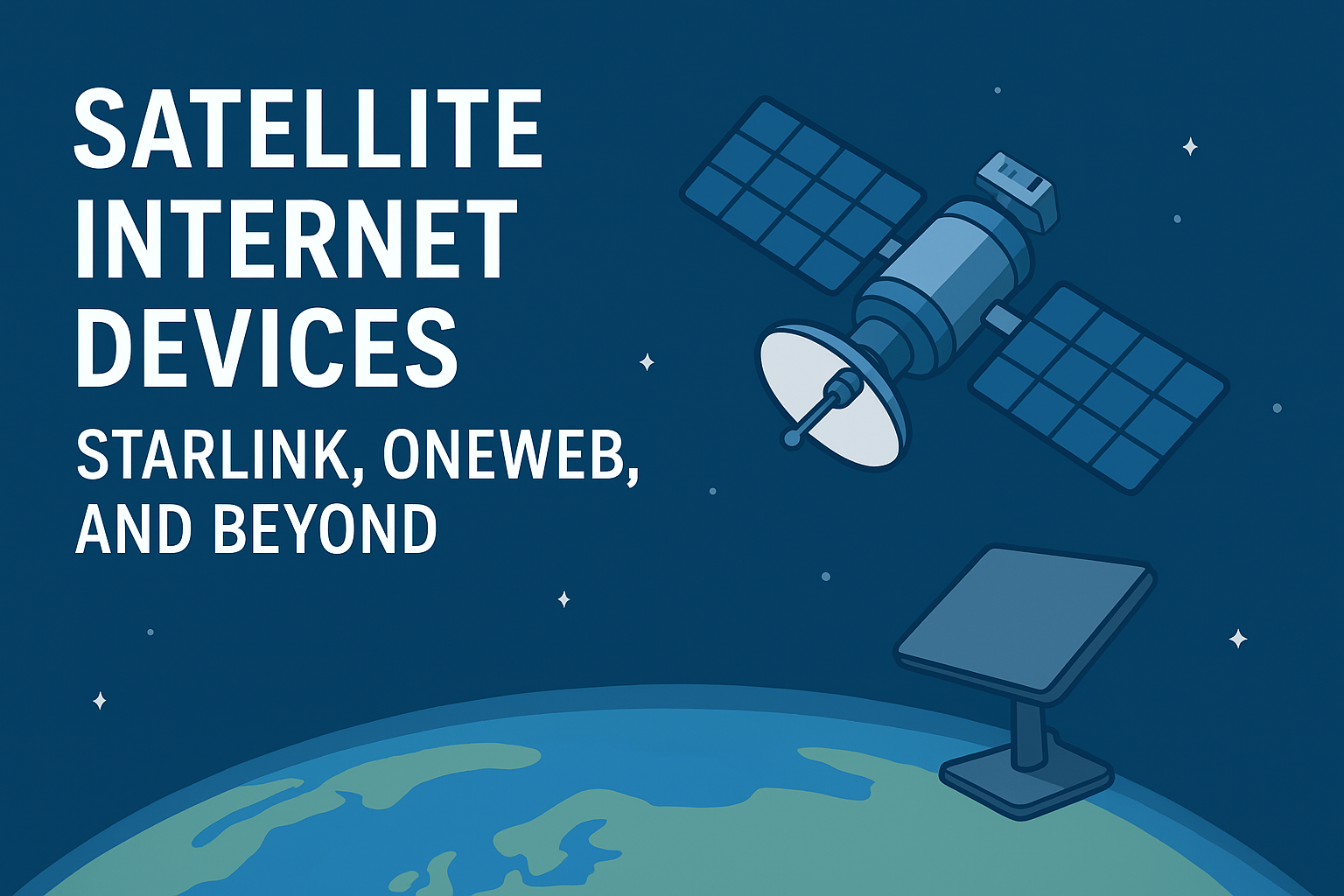Satellite internet devices (Starlink, etc.)
1. Introduction & scope
This article evaluates satellite internet devices and the ecosystems that support them — hardware (user terminals and gateways), satellite constellations, ground infrastructure, and commercial/regulatory frameworks. The focus is on LEO broadband constellations (the fastest-growing category), but we reference GEO and MEO where relevant for contrast. Where possible, this piece cites provider updates, FCC filings, and major market reports to ground claims.
The target audience is technical and commercial decision-makers: network architects, policy analysts, enterprise buyers, investors, and product teams evaluating satellite connectivity as part of a broader connectivity strategy.
2. Why satellite internet matters now: drivers and use cases
Drivers of renewed interest
- Improved performance — LEO constellations deliver materially lower latency than traditional GEO systems (tens of milliseconds vs. hundreds), enabling real-time applications (VoIP, conferencing, interactive cloud apps).
- Mobility demand — Airlines, shipping, and land mobility (trucking, emergency response) need reliable high-bandwidth connectivity on the move.
- Rural & underserved coverage — Satellites bypass last-mile limitations in sparse or geographically difficult regions.
- Resilience & national security — Satellites provide redundancy for critical infrastructure and enable connectivity when terrestrial routes fail.
- Economic scaling — Declining production costs for small satellites, reusability of rockets, and mature mass-production of user terminals reduce unit costs over time.
High-value use cases
- Residential broadband in remote/hard-to-wire regions
- Enterprise backhaul (cell towers, mining, oil & gas)
- Maritime and aviation broadband
- Emergency response and disaster recovery
- Governmental and defense communications
The combination of these drivers explains why governments, corporations, and consumers are seriously adopting satellite internet options as part of mixed connectivity strategies.
3. Technical foundations: LEO vs. GEO vs. MEO and why LEO matters
Orbital basics
- GEO (geostationary Earth orbit) satellites orbit at ~35,786 km, providing wide coverage with stationary beams but high round-trip latency (~500 ms). Historically dominant for broadcast and broadband in remote areas.
- MEO (medium Earth orbit) sits between GEO and LEO (~2,000–20,000 km) and offers a latency compromise; some operators use MEO for navigation and comms.
- LEO (low Earth orbit) satellites orbit at 300–1,600 km (typical LEO broadband constellations operate roughly between 300–1,350 km). LEO reduces propagation delay enabling latencies competitive with terrestrial networks for many applications.
Why LEO is disruptive
- Lower latency — propagation time is proportional to distance; LEO naturally reduces round-trip times.
- Potential for higher aggregate capacity — dense LEO constellations distribute load across many satellites, enabling per-user throughput increases when engineered for capacity.
- Smaller, cheaper terminals — advances in phased-array antennas and integrated RF components allow more compact user devices relative to GEO dish systems.
Network architecture differences
LEO systems require robust satellite handovers, inter-satellite links (laser/optical ISLs in some designs), and many ground gateway stations to route traffic into terrestrial networks. This creates complexity but allows lower latency routing and load distribution strategies not possible with GEO-only systems.
4. Constellations in focus: Starlink, OneWeb, Project Kuiper, and others
Below we profile the major LEO providers shaping the market as of 2025.
4.1 Starlink (SpaceX) — scale, breadth, and product variety
Starlink is the most prominent consumer-facing LEO broadband operator, notable for aggressive satellite launches and an expanding terminal portfolio (residential, RV/roam, maritime, aviation, and Starlink Business). Starlink’s public availability map and product pages indicate broad global availability for consumer plans, specialty kits like Starlink Mini, and higher-capacity business offerings. Starlink’s frequent launches continue to add satellites and new variants to its constellation, improving capacity and enabling new features. Starlink+1
Key attributes:
- Massive launch cadence — large, frequent Falcon 9 launches steadily increase the constellation. Recent launches (e.g., 28 satellites on Oct 7, 2025) add V2 Mini satellites to the network. Spaceflight Now
- Product diversification — consumer residential, portable kits, and specialized aviation and maritime terminals. Starlink
- Regulatory engagement — ongoing filings and compliance with FAA/FCC processes, including requirements for deorbit and data submissions. FCC Docs
4.2 OneWeb (Eutelsat OneWeb) — enterprise & partnership strategy
OneWeb positions itself toward enterprise, government, maritime, and aviation markets, often partnering with regional carriers and telcos (e.g., partnerships for backhaul in Australia). OneWeb’s architecture and partnerships complement Starlink’s consumer reach by targeting B2B segments and verticals. OneWeb’s constellation design and orbital altitude choices reflect tradeoffs between coverage footprint and latency. Eutelsat+1
Key attributes:
- Focused use cases — maritime, aviation, enterprise backhaul, and telco partnerships. Eutelsat
- Collaborations — strategic tie-ups to deliver regional coverage and hybrid solutions.
4.3 Project Kuiper (Amazon) — a deep-pocketed entrant
Project Kuiper, Amazon’s LEO program, received FCC approval for a >3,200 satellite constellation and began deployment in 2025, launching initial satellites in April 2025 per Amazon updates. Kuiper aims to leverage Amazon’s cloud, retail, and logistics strengths to offer differentiated services and integrated products (AWS integration, retail distribution of terminals). Kuiper’s FCC license includes build-out milestones requiring phased launches. Amazon News+1
Key attributes:
- Amazon ecosystem advantage — retail and cloud resources for distribution and value-added services. Amazon News
- Regulatory milestones — launch deadlines and phased deployment obligations under FCC license. Wikipedia
4.4 Other players and regional constellations
- Rivada / Rivada Space Networks and other niche entrants propose secure, private LEO networks targeted at government and enterprise customers. New private network proposals have drawn media attention for scale and targeted use cases. The Times
- Traditional GEO/MEO incumbents (Viasat, SES, Eutelsat) continue serving niche markets and are integrating hybrid models combining GEO capacity with LEO backhaul.
5. User equipment (terminals): design, cost, and evolution
User terminals are a gating factor for mass adoption: they determine installation complexity, per-customer capex, and form-factor suitability for consumer vs. mobility use.
5.1 Terminal categories
- Residential fixed-home terminals — Starlink residential dish, Kuiper home terminal, OneWeb modems connected via partner equipment. Historically, these were relatively large phased-array dishes; form factors are shrinking and costs are declining with scale. Starlink+1
- Portable (backpack/mini) kits — lightweight, quick-deploy units for RVs, pop-up events, and first responders (e.g., Starlink Mini). Starlink
- Maritime & aviation terminals — ruggedized, stabilized phased arrays to maintain link during motion and pitch/roll. Higher price points but pay off in high-value verticals. Starlink
- Professional & enterprise terminals — high-capacity, high-gain arrays for enterprise backhaul, with better SNR and QoS features.
- Embedded modules — upcoming integrated modules for vehicles, industrial IoT devices, and consumer electronics.
5.2 Terminal technology trends
- Phased-array antennas — electronically steer beams without moving parts, essential for LEO tracking and compact installations.
- Integrated RFIC & low-cost manufacturing — systems-on-chip reduce BOM and simplify assembly.
- Multi-constellation and multi-band support — terminals that can service multiple LEO networks (or fall back to LTE/GEO) will be commercially valuable.
- Lower cost through supply chain scale — Amazon’s retail scale and OEM relationships (in Kuiper’s case) and SpaceX’s vertical integration aim to drive down terminal costs.
5.3 Cost trends and affordability
Terminal costs have been a major barrier to mass household adoption. Early LEO terminals were expensive (several hundred to 1000+ USD). As suppliers scale production and competition increases, unit prices are trending down; Amazon’s retail channels and OneWeb partnerships aim to accelerate price pressure. Even with decreasing hardware cost, subscription economics and data caps (if any) determine mainstream consumer uptake.
6. Performance realities: throughput, latency, capacity and bottlenecks
6.1 Latency & throughput
LEO services typically offer:
- Latency: often 20–50 ms under ideal conditions for LEO routing, making cloud apps, gaming, and conferencing feasible—closer to terrestrial copper/fiber experience than GEO.
- Throughput: varies by terminal and plan — consumer plans deliver tens to hundreds of Mbps; business/enterprise tiers advertise higher, often with service level agreements (SLAs).
Actual performance is influenced by:
- Satellite altitude & network architecture — lower altitude reduces latency but requires more satellites to maintain coverage.
- Ground gateway capacity — satellites route traffic to terrestrial gateways; limited gateway capacity can create congestion when demand spikes in concentrated areas.
- Beam densification and frequency reuse — operators use tight beams and reuse spectral resources to increase aggregate capacity.
Recent technical analyses point out that while LEO can hit high speeds under favorable conditions, real-world performance is heterogeneous and dependent on user density, terminal placement, and gateway provisioning. Reports analyzing coverage versus federal broadband standards show that Starlink meets speeds in many low-density contexts but may struggle to meet federal thresholds in denser rural regions without further capacity growth. Broadband Breakfast
6.2 Bottlenecks & capacity limits
- Gateway congestion — without sufficient terrestrial backhaul and gateway distribution, local capacity can be constrained.
- Spectrum constraints — LEO operators must coordinate spectrum use and face cross-border regulatory constraints.
- User concentration — tourist areas or localized events can overwhelm local satellite capacity transiently.
6.3 Quality management & SLAs
Enterprise and government customers require measurable SLAs (latency, packet loss, uptime). LEO operators offer tiered products and SLAs for these verticals, whereas consumer plans remain more “best effort” with evolving fairness policies.
7. Business models & vertical markets
LEO satellite operators adopt diverse go-to-market strategies based on market segments.
7.1 Consumer broadband
- Direct-to-consumer (D2C) — subscription plans sold directly via websites and retail partners; consumer adoption depends on price, performance, and availability. Starlink has pursued D2C aggressively. Starlink
- Retail distribution — Project Kuiper’s synergy with Amazon retail offers a volume distribution advantage.
7.2 Enterprise & wholesale
- Backhaul for telcos — satellite links used to connect remote cellular towers or IoT gateways where fiber is uneconomical.
- Hospitality & remote work sites — resorts, mining sites, oil rigs purchase high-capacity terminal packages.
- Wholesale to ISPs — regional ISPs may resell satellite capacity under localized plans.
7.3 Mobility (maritime, aviation, vehicle)
- Maritime & aviation — premium services for passenger connectivity and crew operations; revenue per user is higher but so is the cost of terminals and installation. Starlink, OneWeb, and others have explicit maritime/avionics products. Starlink+1
7.4 Government & defense
- Secure, resilient comms — governments procure dedicated or prioritized capacity, with security, encryption, and assured availability. Rivada and other proposed private constellations target this market specifically. The Times
7.5 Bundling & cloud integration
Kuiper’s integration with AWS or Starlink/other partnerships with cloud providers can enable novel bundles: connectivity + managed cloud services, edge compute, or retail-bundled consumer deals.
8. Market size, forecasts, and economics
Market estimates vary by methodology and segment. Representative reports indicate strong growth:
- MarketsandMarkets projects LEO & GEO satellite internet market growth with a projected increase from USD ~14.6 billion in 2025 to over USD 33 billion by 2030 (CAGR ~18%). MarketsandMarkets
- Other forecasts (Fortune Business Insights, ResearchAndMarkets) produce similar high-teens CAGR projections for the broader satellite internet market through the end of the decade. Fortune Business Insights+1
Key economic drivers:
- Terminal cost declines: lower capex encourages adoption.
- Average revenue per user (ARPU): varies by vertical — consumer ARPU lower than maritime/aviation or enterprise.
- Launch & replacement costs: ongoing replacement of short-lived LEO satellites and launch cadence impacts OPEX and capex.
- Spectrum & ground infrastructure: gateway costs and terrestrial backhaul affect the marginal cost per customer.
9. Regulatory landscape & policy: spectrum, licensing, and national concerns
Satellite internet sits at the intersection of international spectrum law, national licensing, and aviation/maritime regulation. Recent regulatory developments show active policy evolution.
9.1 FCC and US regulatory actions
The FCC and other national regulators manage licensing, spectrum assignment, and environmental/licensing obligations. In 2024–2025 the FCC updated procedural details and adopted reforms to licensing and de-orbit requirements; operators must provide information on deployed satellites and comply with deorbit timelines and safety reporting. New reforms also aim to accelerate licensing of earth stations and support “ground-station-as-a-service” models. FCC Docs+1
9.2 International coordination
- ITU filings & coordination are required to avoid harmful interference across borders.
- Export controls and national security: governments may restrict hardware exports or operational use for sensitive sectors (defense, critical infrastructure).
9.3 Policy debates
- Digital equity & subsidy eligibility — how to treat satellite providers in broadband subsidy programs (e.g., BEAD in the U.S.) is a policy debate: parity vs. differentiated treatment due to technological differences. Operators have lobbied for parity treatment so that satellite broadband can participate in funding programs. TeckNexus
- Space traffic management — as constellations scale, regulators are focused on collision risk, debris mitigation, and deorbit standards.
10. Interoperability, roaming, and peering with terrestrial networks
Sustainable satellite internet deployments require seamless integration with terrestrial ISPs and cloud providers.
10.1 Peering & routing
Operators interconnect with major internet exchanges and cloud providers through ground gateways. Direct peering reduces latency and improves throughput for cloud services.
10.2 Roaming & multi-network terminals
Terminals that can switch between multiple satellite networks (or satellite + cellular) will provide superior resilience and cost optimization. Multi-constellation support is a commercial differentiator.
10.3 Ground station networks & edge compute
Hosted ground-station services (neutral host) and distributed gateways improve local capacity; coupling edge compute at gateways reduces backhaul requirements for latency-sensitive applications.
11. Environmental, safety, and space-traffic management issues
11.1 Debris & reentry
The rapid proliferation of LEO satellites increases collision risk and atmospheric reentry events. Some media accounts note increasing satellite re-entries and burnups as operators deorbit older satellites — raising both safety and environmental questions. Operators are required to design deorbit capabilities into satellites and coordinate with space traffic authorities. PC Gamer
11.2 Emissions & sustainability
Life-cycle analysis of satellite networks (manufacturing, launches, orbital lifetimes) is an emerging field; operators and regulators will face scrutiny for environmental impacts and debris mitigation.
11.3 Policy & industry responses
Regulators (e.g., FAA, FCC) and industry consortia are adopting or proposing standards for deorbit timelines, collision avoidance coordination, and transparency on satellite health and location to mitigate risks. FCC Docs
12. Competitive dynamics and new entrants
12.1 Incumbents & challengers
- Incumbent satellite operators (Viasat, SES) are adapting through hybrid satellite layers or partnerships.
- New entrants (Rivada, regional LEO projects) propose specialized and secure networks targeting government or enterprise buyers. The Times
12.2 Vertical competition & partnerships
Operators partner with telcos, maritime service providers, and aviation OEMs to deliver integrative solutions. Strategic partnerships (e.g., OneWeb + Eutelsat or telco collaborations) accelerate regional adoption.
12.3 Price & terminal competition
Terminal cost competition—driven by scale and manufacturing—will be a decisive factor. Retail distribution advantages (e.g., Amazon + Kuiper) and vertically integrated supply chains (SpaceX verticals) create differentiated competitive pressures.
13. Risks, limitations, and adoption barriers
- Terminal cost and installation complexity — decreases are occurring, but upfront costs and professional installations for certain verticals slow adoption.
- Spectrum scarcity & interference — coordination between operators and national regulators is nontrivial.
- Concentrated demand & gateway limits — hotspots of demand can produce localized service degradation without more satellites or gateways.
- Policy uncertainty — subsidy program treatment, cross-border licensing, and security restrictions create business risk.
- Environmental & collision risk — perception and reality of space debris raise long-term operational risks.
- Competition from terrestrial technologies — fiber, 5G fixed wireless access (FWA) and millimeter-wave solutions may be more economical in denser areas.
14. Roadmap and innovation priorities (next 3–5 years)
Technology & operations
- Terminal cost reduction through integrated RFICs and mass manufacturing.
- Multi-band, multi-constellation terminals for resilience and roaming.
- Inter-satellite optical links to reduce reliance on ground gateway density.
- Network slicing & QoS for segmented services (e.g., enterprise vs. consumer).
- Improved on-orbit servicing & debris mitigation technologies.
Market & policy
- Clear regulatory frameworks for subsidies, national security use, and space traffic coordination.
- Standards for performance measurement to help buyers compare operators fairly.
- Public-private partnerships for rural broadband programs integrating satellite options.
15. Conclusion and recommendations for stakeholders
For network architects and enterprises
- Evaluate satellite connectivity as a complementary path for redundancy and for bridging last-mile gaps. Pilot tests are essential to understand real-world throughput and QoS in your operating region. Prioritize terminals that support multi-constellation support and clear SLAs for enterprise use.
For policymakers
- Design subsidy programs and procurement mechanisms that account for satellite characteristics (latency, capacity) while ensuring consumer protections. Invest in spectrum coordination and space traffic management to safeguard future orbital sustainability.
For investors & product teams
- Favor operators and suppliers with clear manufacturing scale advantages, diversified vertical partnerships, and strong gateway/peering arrangements. Terminal suppliers with low BOM costs and retail distribution strengths are strategic assets.
For consumers
- Satellite internet is increasingly viable for rural or mobility use cases. Compare actual speed/latency reports in your locale and understand installation, pricing, and any fair-use or roaming policies.
Appendix A — Glossary (short)
- ARPU: Average revenue per user.
- Beamforming: Technique to direct RF energy toward a target.
- GEO / MEO / LEO: Orbits described earlier.
- Phased-array antenna: Electronically steerable antenna used for LEO tracking.
- ISL: Inter-satellite link (often optical) connecting satellites in space.
Appendix B — Methodology & sources
This report synthesizes provider updates, regulatory filings, and market research published through mid-2025. Key sources used in this article include official provider pages and press releases, FCC filings and public notices, market research reports, and reputable news coverage. Representative citations used throughout the article are below for readers who want to dig deeper:
- Starlink product pages and availability — Starlink official site. Starlink
- Recent SpaceX Starlink launches (example: Oct 7, 2025 Falcon 9 mission adding satellites). Spaceflight Now
- OneWeb / Eutelsat OneWeb constellation and service descriptions. Eutelsat+1
- Project Kuiper official updates and FCC license requirements. Amazon News+1
- Market forecasts on LEO & GEO satellite internet market growth (MarketsandMarkets, Fortune Business Insights, ResearchAndMarkets). MarketsandMarkets+2Fortune Business Insights+2
- FCC public notices and licensing reforms impacting satellites and ground stations. FCC Docs+1
- Technical and policy reporting on service performance and federal broadband standards analyses. Broadband Breakfast
- News coverage of private secure networks and new entrants (e.g., Rivada Outernet). The Times+1
Appendix C — Selected tables & quick references
Table 1 — Representative comparison: Starlink, OneWeb, Project Kuiper (2025 snapshot)
| Attribute | Starlink (SpaceX) | OneWeb (Eutelsat OneWeb) | Project Kuiper (Amazon) |
|---|---|---|---|
| Primary focus | Consumer + mobility + enterprise | Enterprise, maritime, aviation, telco partnerships | Consumer, enterprise; AWS integrations |
| Constellation status | Large & growing; frequent launches | Operational LEO fleet focused on enterprise | Initial deployments began 2025; target 3,236 satellites (FCC license) |
| Terminal types | Residential, Mini, Business, Maritime, Aviation | Partner terminal ecosystem, maritime/enterprise | Home terminals, planned mobility terminals; retail distribution advantage |
| Latency (typical) | ~20–50 ms (LEO range, var.) | LEO range, depends on orbit altitude | LEO target latency similar once deployed |
| Notable strength | Launch cadence & vertical integration | Telco partnerships; enterprise positioning | AWS + Amazon retail ecosystem |
(Sources: provider updates and press releases). Starlink+2Eutelsat+2
Closing note
Satellite internet devices and LEO broadband constellations represent a major structural shift in global connectivity architecture. For many use cases — mobility, maritime, enterprise backhaul, and rural coverage — they are already a practical option. As deployment scales, key success factors will be terminal affordability, gateway infrastructure, regulatory clarity, and responsible space stewardship. Operators that can balance technical performance, cost, and compliance while forging strong distribution and cloud partnerships will lead the next phase of global broadband expansion.
Share this content:














Post Comment